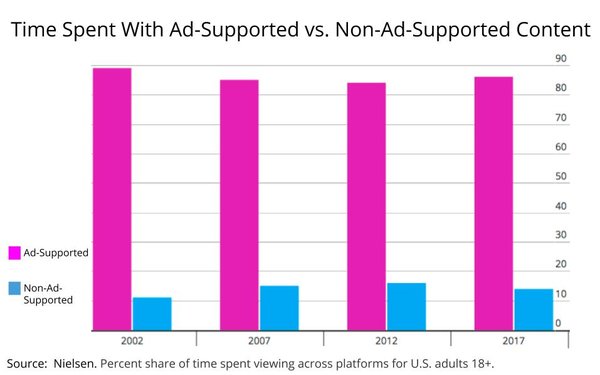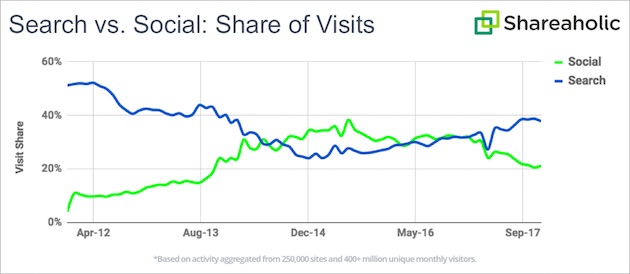Time spent on ad-supported vs. non-ad-supported media, growth in Google Chrome Articles for You recommendations, traffic driven by search vs. social, Facebook user numbers, and more are covered in this installment of TFP’s Media Metrics roundup.
To help you keep up with trends and prepare for changes just around the corner, every quarter we compile excerpts from some key reports covering issues affecting the publishing and media industries. Here are our top picks.
 Time spent in the Nielsen universe: Ad-supported vs. non-ad-supported (Research Intelligencer)
Time spent in the Nielsen universe: Ad-supported vs. non-ad-supported (Research Intelligencer)
- According to a Nielsen report, the amount of time consumers spend on ad-supported content via TV, radio, smartphones, video games, tablets, and other media has stayed “relatively flat” over the past 15 years: 86% in 2017 vs. 89% in 2002.
- “Although consumption of ad-supported media has varied over the past 15 years, it is still far more dominant and successful than perception may indicate,” Nielsen said in the report. It noted in Q2 2007, adult consumers on average spent about 50 hours per week with media while in Q2 2017, that number rose to 75 hours per week—with almost 65 of those hours spent on ad-supported platforms.
- From 2012 to 2017, average weekly hours spent on ad-supported TV, radio, and digital content went up by 15 hours, representing a 30% increase.
This is the next major traffic driver for publishers: Chrome’s mobile article recommendations (Nieman Lab)
- Traffic from Google Chrome’s Articles for You grew an astounding 2,100% last year, making it “one of the fastest growing sources of publisher traffic on the Internet,” according to a recent report.
- The feature drove 341 million visits per month to publishers using Chartbeat last year, compared with 15 million visits per month previously.
- Although Chartbeat only tracks Articles for You referrals from Android, not from iOS, “its Android referrals alone are now about two-thirds the size of all of Twitter (desktop, Android, iOS) in terms of the volume of traffic sent,” the report says.
- Some 72% of the pages Articles for You surfaces are Google Accelerated Mobile Pages, “where visitors are 35 percent more engaged than on the standard mobile web,” according to the report.
 Search overtakes social as top traffic driver to websites (MarketingProfs)
Search overtakes social as top traffic driver to websites (MarketingProfs)
- For the first time in three years, search drove more traffic in 2017 than social, generating 35% of website visits vs. 26%, respectively.
- While Facebook drove 31% of site visits in the first half of 2016, that figure dropped to 18% in the second half of 2017, following algorithm changes.
- Not surprisingly, in the second half of 2017, Google generated the most website visits: It accounted for almost 37% of traffic while Bing made up less than 1%.
Facebook users aren’t going anywhere (The Motley Fool)
- A survey by Raymond James found little change in Facebook user numbers in the wake of the Cambridge Analytica data privacy scandal, with 73% of respondents using the site in March compared with 74% last October.
- The survey also showed little change in usage of Facebook’s Messenger app and Instagram over the same five-month period.
- However, 50% of users said they will use Facebook less frequently, with 26% planning to use the site somewhat less and 19% saying they will use it significantly less. Only 8% plan to quit Facebook entirely.
Amazon spent nearly $23 billion on R&D last year—more than any other U.S. company (Recode)
- Combined, technology companies spent $76 billion on research and development in 2017, again taking the top five spots in the U.S. for R&D spending.
- Amazon was No. 1 with R&D spend of $22.6 billion last year, a jump of 41% over 2016. It was followed by Alphabet, Intel, Microsoft, and Apple.
- Facebook came in ninth on the list, increasing its year-over-year R&D spending 32% to $7.8 billion.
Zenith: Online advertising will exceed 40 percent of global ad spend this year (Fipp)
- Zenith revised its 2018 forecast for global ad growth from 4.1% to 4.6%.
- It attributed the new forecast to economic growth in Argentina and China, predicting the latter will see 8% growth in ad spending this year, up from its 6% forecast in December. China, the world’s second biggest ad market, accounts for 15% of global ad spending, Zenith said.
- In terms of individual media markets, “we see no evidence that advertisers as a whole are going to start shifting budgets away from online advertising any time soon,” the researcher said, noting online advertising grew by 13.7% in 2017 and this year will make up 40.2% of total global spending.
One-third of US consumers own two or more smart home devices (GfK)
- In a recent survey, 58% of respondents said smart home devices are “likely to change their lives in the next few years.” That figure is even higher (68%) among respondents ages 25 to 34.
- In measuring the impact of 11 emerging digital technologies, the researcher found smart home devices topped the list as the most likely to affect respondents, followed by payment services (52%), and technology including wearables, cloud computing, and connected vehicles (between 30% and 40%).
- However, while 68% of millennial respondents said they expect a high level of cross-device communication, “the industry is still working to achieve that in many cases,” according to the survey findings.
TV ad spending finally fell in 2017 (Recode)
- According to eMarketer, TV advertising spend in 2017 dropped for the first time since the recession in 2009, decreasing 1.5% year over year to $70.2 billion.
- TV ad spending is expected to fall over the next two years as well—a 0.5% decline this year and a 1% drop in 2019.
- The researcher projected TV ads will account for 32% of all U.S. ad spending in 2018, down from 34% in 2017 and 37% in 2016.
64% of tracking cookies are blocked, deleted by web browsers (Digital News Daily)
- An ad-serving firm that analyzed 5 billion impressions in Q4 2017 found that 64% of their tracking cookies were blocked or deleted by browsers.
- Some 75% of cookies were rejected on mobile devices compared with 41% on desktops. More than 80% of tracking cookies on tablets were rejected or deleted.
- For typical advertisers, 29% of users rejected or deleted cookies.
The hidden cost of time wasted on data, by industry (Research Intelligencer)
- According to recent PointSource research, most organizations waste time every day on organizing and sharing data, with 46% saying such activities account for an hour or more of lost productivity. Only 10% of senior decison-makers said no time was wasted on data sharing activities.
- The study pegged the average annual cost per wasted employee hour at $7,739.64.
90 percent of affiliate ads on YouTube and Pinterest aren’t disclosed, says study (The Verge)
- According to research conducted at Princeton University, 90% of affiliate content on YouTube and Pinterest isn’t disclosed as such to readers.
- The study also found that on both platforms, posts with affiliate links drove higher user engagement.
- FTC-recommended explanation disclosures appeared in only 1.82% of affiliate content on YouTube and 2.43% on Pinterest.
Charts: Nielsen, Shareaholic
Media Metrics is a monthly feature from Technology for Publishing, aimed at keeping you armed with the latest industry data. If you’d like to share something you’ve read, drop us a note. And keep up with the latest industry news coverage by signing up for our This Week in Publishing emails and our Publishing Innovations newsletter.
Posted by: Margot Knorr Mancini


